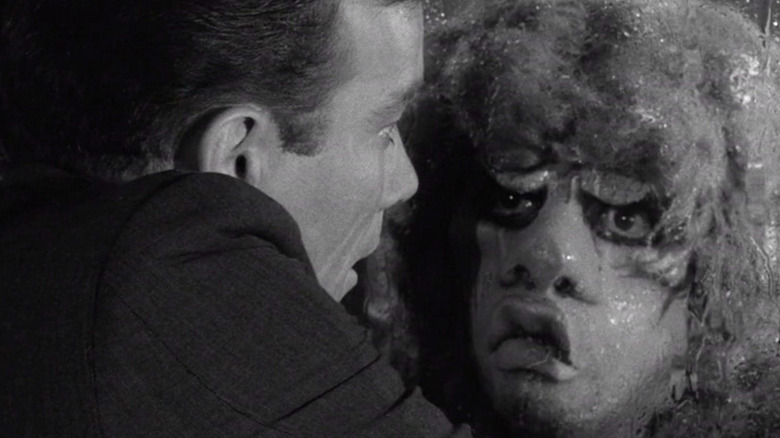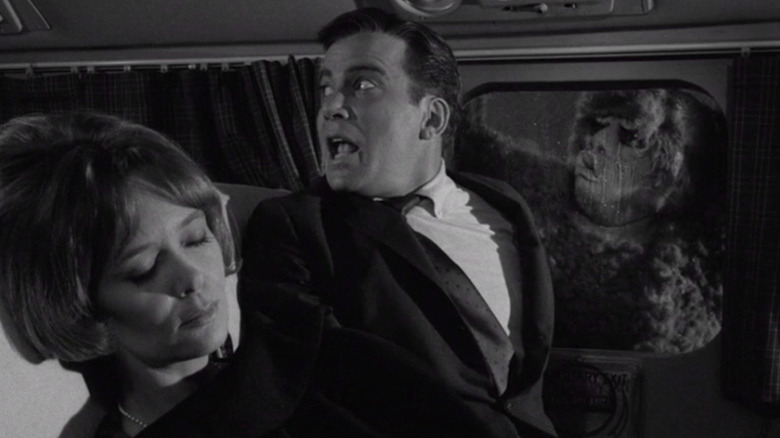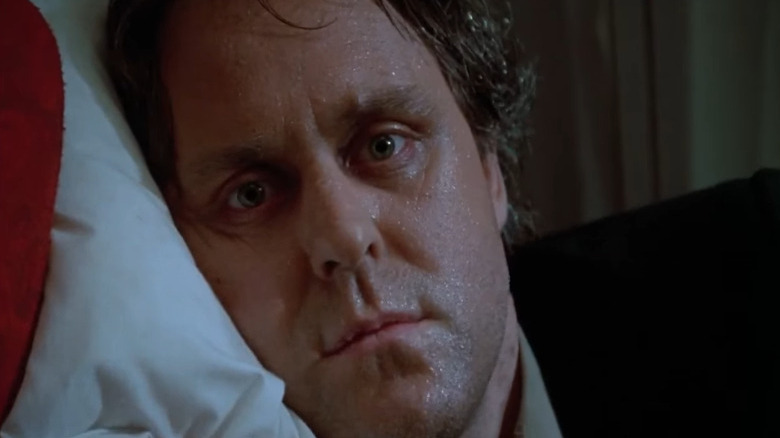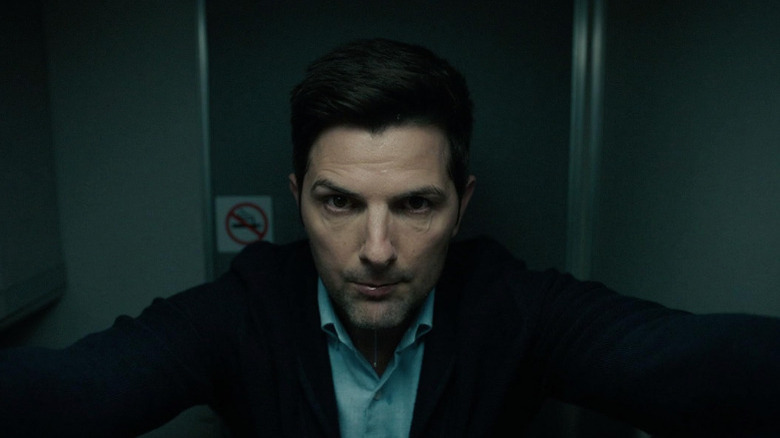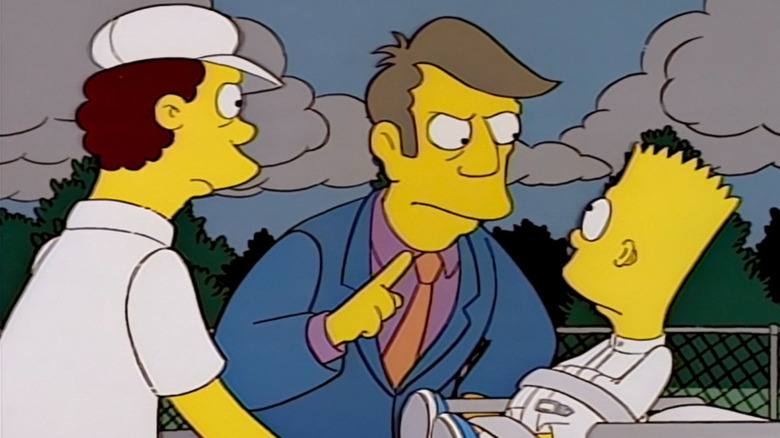The Twilight Zone Story So Scary, They Made It Three Times
The sci-fi/horror anthology series "The Twilight Zone" has always had the power to completely blow our minds, with classic episodes that taught fraught moral lessons, and featured twist endings that would eventually become so iconic that modern audiences are likely to watch episodes for the first time around pre-spoiled, whether they realize it or not, just due to cultural osmosis.
But there is perhaps no episode of "The Twilight Zone" quite like "Nightmare at 20,000 Feet." The episode is a claustrophobic thriller about a man on an airplane suffering from intense anxiety, who looks out and sees a man on the wing of the plane. Naturally, no one believes him because when anybody else looks, the man mysteriously vanishes. Only our hapless hero, sanity fraying, knows that the plane is in danger from the mysterious entity. With nobody else willing to believe him, he has to make a terrible, dangerous decision if he wants to save all the passengers' lives ... even though they might never understand his sacrifice.
Harrowing, unusual, tightly-constructed, and disturbingly sympathetic, "Nightmare at 20,000 Feet" is such a powerful and legendary episode of television that it's actually been remade multiple times, each with new twists that alter the story in meaningful ways. So why does this story endure, and how do the three versions stack up?
There's a man on the wing of the plane!
The original "Nightmare at 20,000 Feet" comes with an impressive pedigree. Genre legend Richard Matheson, who also wrote the original sci-fi classics "The Incredible Shrinking Man" and "I Am Legend," adapted his own short story for television and future "Superman" and "The Goonies" director Richard Donner was behind the camera. The episode starred William Shatner, three years before the debut of "Star Trek," which would make him a household name.
Shatner plays Robert Wilson, who is flying home with his wife after being institutionalized following a nervous breakdown. He's not specifically afraid of flying, just anxious in general. As soon as he sees the man on the wing of the plane and sees how people respond to his admittedly-strange proclamation, he becomes self-conscious and paranoid that people aren't taking him seriously, or just humoring him.
The genius of the story is two-fold. On one hand, the constant frustration Wilson feels when nobody can see what he sees is borderline comical. The "Looney Tunes" short "One Froggy Evening" (1955) has a similar premise, where a man acquires a frog that sings showtunes but whenever he shows anyone else, the frog refuses to perform. This gradually drives him mad and ruins his life. The audience knows he's not insane, but nobody else does, and it's painful to watch.
But unlike Michigan J. Frog, the man Wilson sees on the wing of the plan isn't benign. This entity is going to crash the airplane, so instead of being funny it's maddening to Wilson and the audience as well. We know he is telling the truth, and we can sympathize with the passengers and flight crew for not believing him, but their "rationality" is going to get them all killed. It's a perfect panic attack of a premise; simultaneously logical and illogical, sane and insane.
There's another man on the wing of the plane!
"Nightmare at 20,000 Feet" was one of four classic "Twilight Zone" episodes that were remade in the 1983 anthology horror film "Twilight Zone: The Movie." Okay, strike that: three classics and "Kick the Can," an overwhelmingly treacly installment directed by Steven Spielberg in the feature film version. The other installments include "It's a Good Life," a tale about a godlike child directed with horrifying mischievous by Joe Dante, and "Time Out," a mashup of the episodes "Back There" and "The Quality of Mercy," in which a racist goes back in time to experience persecution first hand. (The production of "Time Out" is notoriously tragic, and led to the deaths of star Vic Morrow and two child actors.)
The final installment was a remake of "Nightmare at 20,000 Feet" directed by George Miller of "Road Warrior" fame and starring John Lithgow at his most unhinged, which is saying something. Miller's rendition is explicitly about aviophobia, the fear of flying, and finds Lithgow's character John Valentine already having a panic attack in the bathroom as the story begins.
Donner's direction focused more on the rational aspect of the story, but Miller goes to extreme lengths to place us in Valentine's mindset. Lenses that warp the screen plunge us into his fears. Every character seems designed to make him more uncomfortable, even a little girl whose constant yelling and insensitivity makes every moment 100x worse. When Valentine gets a good look at the creature on the plane you can even see a few frames where his eyes literally bulge out of his skull, a gag Miller used back in the first "Mad Max."
What's more, Miller's version of the monster is infinitely scarier than the original. The first creature looked like a fuzzy teddy bear. Miller's monster is a freaky demon with a sharp-toothed grin and giant, penetrating eyes.
There's a podcast on the topic of this plane!
Decades later, Oscar-winning "Get Out" director Jordan Peele led a reboot of "The Twilight Zone" television series. Although it was hardly the first "Twilight Zone" reboot, and with only two seasons it wasn't particularly popular (the 1980s reboot lasted three full seasons, and produced three times as many episodes), but it did produce a quasi-remake of "Nightmare at 20,000 Feet" that took the premise in a very new direction.
The episode "Nightmare at 30,000 Feet" (even though the plane is at 35,000 feet) finds protagonist Justin Sanderson (Adam Scott) on an airplane after a bout of intense post-traumatic stress disorder. He discovers an MP3 player in the pouch next to his seat and soon realizes that it's playing a podcast about mysterious airline disasters, and the episode he's listening to is about the plane that he's on. Nobody believes him, of course, and the podcast host ("Hardcore History's" Dan Carlin) doesn't know what caused Sanderson's plane to vanish, only that it will do so in 45 minutes.
"Nightmare at 30,000 Feet," directed by Emmy-winner Greg Yaitanes ("House of the Dragon"), may alter the engine of suspense but if you can get over that it's a mostly satisfying thriller, which capably explores modern airline anxieties and our weird collective fascination with disasters. It also has a couple of twist endings, one of which disturbingly subverts one of the best parts of this tale.
There's a gremlin on the side of the bus!
In his novel "Hannibal," author Thomas Harris wrote a line that speaks to the dramatic and suspenseful power of these "Twilight Zone" episodes: "There is a common emotion we all recognize and have not yet named — the happy anticipation of being able to feel contempt."
The protagonists of the three "Nightmare" episodes all know that, although they sound insane, they're telling the truth. And even though all their fellow passengers are acting rationally in response to their irrational claims, and even though they're all willing to save those passengers at the cost of their own lives, our heroes — and the audience — long for a specific catharsis. Not the safety of the passengers, but the revelation that those other passengers were wrong and the seemingly insane protagonist was 100 percent correct the whole time, and that some serious apologies are in order.
The first two versions of "Nightmare at 20,000" feet don't give us that catharsis, but they imply that it's coming. Both stories end with the discovery of a damaged wing that might not prove the protagonist's right, but at least proves that they were onto something. "Nightmare at 30,000" ends more subversively, but its ending is not as well-known, and isn't worth spoiling in detail.
Perhaps the best ending of all, though, comes from the fifth "Treehouse of Horror" episode of "The Simpsons," which parodies the tale, gives us a catharsis, and then snatches it away. Bart tries to save his school bus from a gremlin, and afterwards, the damage is discovered and everyone admits he was right. But it doesn't matter. As Principal Seymour Skinner says, "Right or wrong your behavior was still disruptive, young man. Perhaps spending the remainder of your life in a madhouse will teach you some manners."
Perpetually right, and perpetually doomed anyway.
